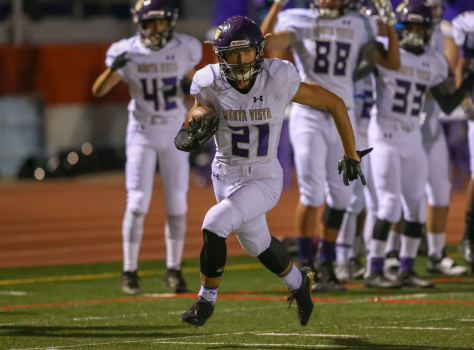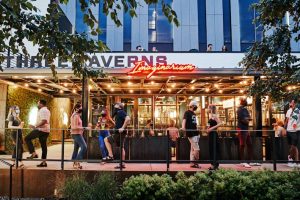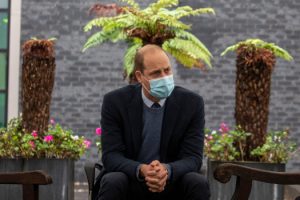Monta Vista High School football player Derek Zheng (21) runs downfield against Saratoga in a SCVAL El Camino Division football game at Saratoga High School, Saratoga CA on 10/5/18. (Photograph by Bill Gerth) (Monta Vista 29 Saratoga 55)
Editor’s note: This is one in a series of Q&A’s that Bay Area Preps HQ is doing with high school league commissioners throughout the region in advance of the scheduled start of practice for sports such as football, volleyball and water polo in December. Look for links to the published Q&A’s here.
Brad Metheany, the commissioner of the Santa Clara Valley Athletic League, just wants to see kids at the schools he oversees back outside playing again.
Metheany can sense student-athletes are eager to play, too, as more are participating in “summer” workouts than in any other year.
Of course, they’re working out under strict guidelines — within their pods of 20 students in outdoor facilities only.
The SCVAL, a two-division league that includes football heavyweights Wilcox, Milpitas, Los Gatos and Palo Alto and 14 schools overall, is scheduled to return to practice for its traditional fall sports on Dec. 14.
Metheany spoke with Bay Area Preps HQ last week to address possible protocols, testing and what it will take for the season to begin smoothly for his league’s schools.
Here’s what he said.
What is the Santa Clara Valley Athletic League allowing teams to do now?
“We have five superintendents for 14 schools that make decisions on what we can do with ‘summer’ practice. Right now almost all of them are working out in pods of 20. Almost all are using some equipment. Some schools are using more based upon what their superintendent has decided. Right now they’re all working out, and they’re starting to do some team development as we get closer to Dec. 14.”
What are the health and safety protocols that your league is following?
That depends on the school. Each superintendent needs to set protocols for their kids and they sit down with the athletic directors to do so. So for me to give you a protocol for the whole league, we don’t have one. We have five districts setting their protocols for their students.
Are schools well versed in the protocols they need to follow?
“Yeah, that communication within their districts is pretty good. We know we have some districts that do something a little bit different. There’s some schools who ask, ‘How come that school gets to do this?’ and I have to explain that different districts have different rules, as per their superintendent. That’s hard to explain to some coaches because sports all follow a specific rule book. For example, some of our really good football teams are going to play teams outside of our section. Say, Pittsburg, or a team in Southern California. Those guys are under different rules too, and coaches are wondering if they can keep those games in place under these new restrictions.”
What do you need to hear from the county to proceed with the season?
“One of the things that came up was a couple of schools and districts said not to use any equipment. Well nowhere in the state or county guidelines was that ever written, so I don’t know where that came into play. But that was a decision they made. So, you know, as we creep forward to Dec. 14, I think some of those things will come down from the (California Interscholastic Federation). And then our own section we’ll make some decisions. But district superintendents can OK when it’s time to play. They’ll ask the districts, ‘OK, who’s in?’ Five districts can say they’re in and one might say they aren’t in for season one. And that’s going to be totally up to them.
“I’m hoping that’s not the case. Even if we don’t have school, even if they’re not in classrooms, even in a hybrid modified way. I think kids are going to need athletics and activities after school. More than ever before. They need to have some outlet. Kids are coming to practice more than they ever did before. I would say, don’t tell me because we don’t have school that we can’t have athletics. I would probably say we need sports probably more than that.
“I think after the election Tuesday, the state CIF will make some decisions that will trickle down to our section commissioner and then our superintendents. And superintendents have so much to do. This isn’t high on their priority list. I have to remind my athletic directors all the time that superintendents are getting it every which way they can from teachers’ unions, parents — so don’t fight them, work with them. But I want us to do this no matter what.”
How optimistic are you that the season will go on in January?
“I’m very, very hopeful, and that’s what my stance has been for a while. I want us to have hope that is going to happen. I’m not going to think any other way and I’m going to adjust if I have to. The amount of work that went into changing all the schedules and working on a matrix of putting games together. I mean, in season two there’s so many sports — soccer, baseball, softball, track — across all one facility. We did a lot of work trying to get them where they don’t overlap. So there’s a lot of work, but if there needs to be more work, we’ll do it. We’ll adjust because it’s going to be important for these young people to have this outlet.”
Do you think testing will be required?
“That’s going to be a district decision. I hope the state gives some basic guidelines of what you have to do daily. And I think the section will do that also. I think I’m more worried about our coaches contracting and how we’re going to test them. Let’s not be naive, we have a lot of coaches that come from work, not always on campus. We’re not there yet.
“I don’t doubt there will be some protocols set in place for testing. It’s being improved daily, monthly. There might have to be buy-in for families to participate. I wouldn’t anticipate anybody starting without some testing protocols in place.”
Is there a concern that some districts can have resources for testing as opposed to others?
“Absolutely. I have 14 public schools. There’s a lot of costs going into everything to make the schools prepared and safe. Those cost factors are going to be dramatic. Public school students don’t pay to participate, and some have bigger numbers of low-income families and some don’t. That’s going to be a heavy burden to districts when they weigh it all. And it won’t just be athletics as a burden.
“I anticipated this coming and downsized our league budget by 10 percent, including cutting my salary, because I worked in the system as an administrator for so long. So, I think those are things we have to face because public schools are public schools and we aren’t going to deny anybody.”
Do you have any idea of what the health and safety protocols will be like at games?
“The next item on the agenda with athletic directors will be to tell schools, just because we don’t have spectators doesn’t mean you don’t have supervision. That will be an important conversation that each league will have to have with what they do to supervise contests to whatever level the county will allow. Counties could allow 25% capacity in. They could allow none in. Schools will all need to be on the same page.”
Is there any situation in which you see some teams in your league cleared to play and others not?
“Yes. We could have a COVID outbreak in school. That school would be removed until they are ready to come back — like the NFL has done. And the games they miss are not forfeits, they’re byes. I don’t see districts opting out completely. I hope not. But I can see an outbreak.
“Here’s what I feel good about, people are not going to care. They’re going to say, ‘OK, that’s too bad for them, we still get to play games. They’re not going to worry about how it will affect my championship, how to look at my points for CCS. They’re going to say, ‘Gee, that’s too bad for them. OK, Thursday I have a game against this other school.’ That is the one byproduct everyone understands right now. Can we have some fun and compete?”



















